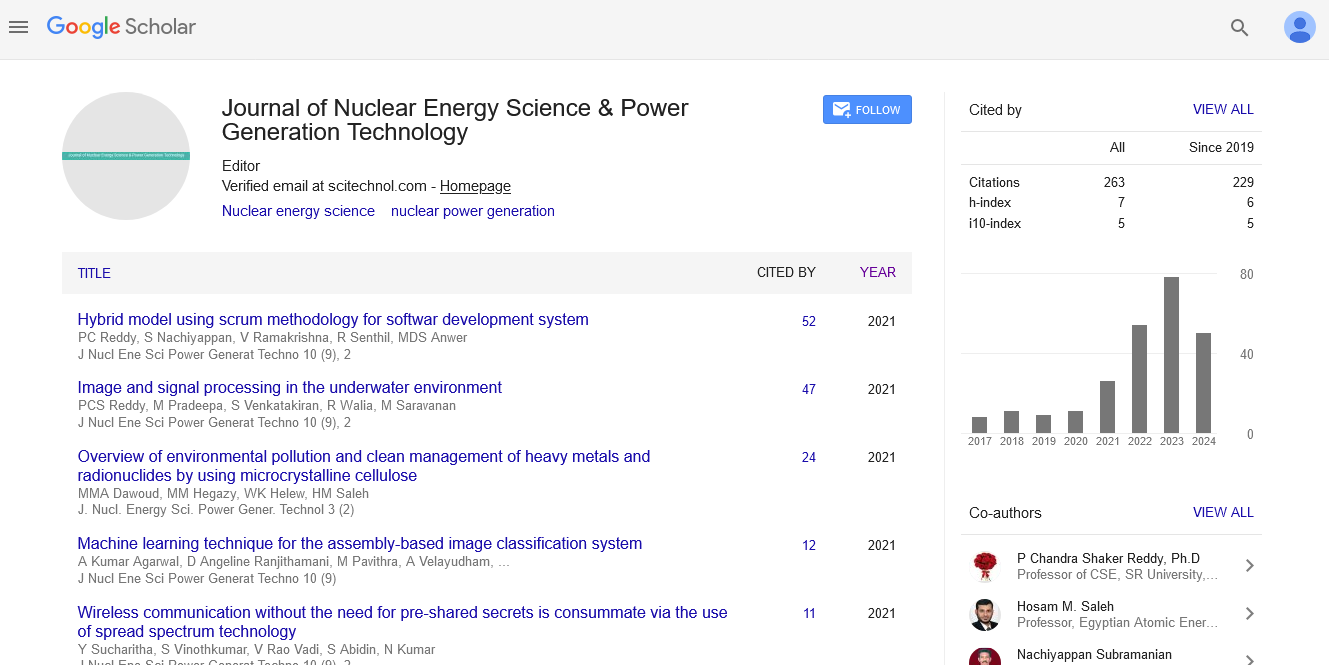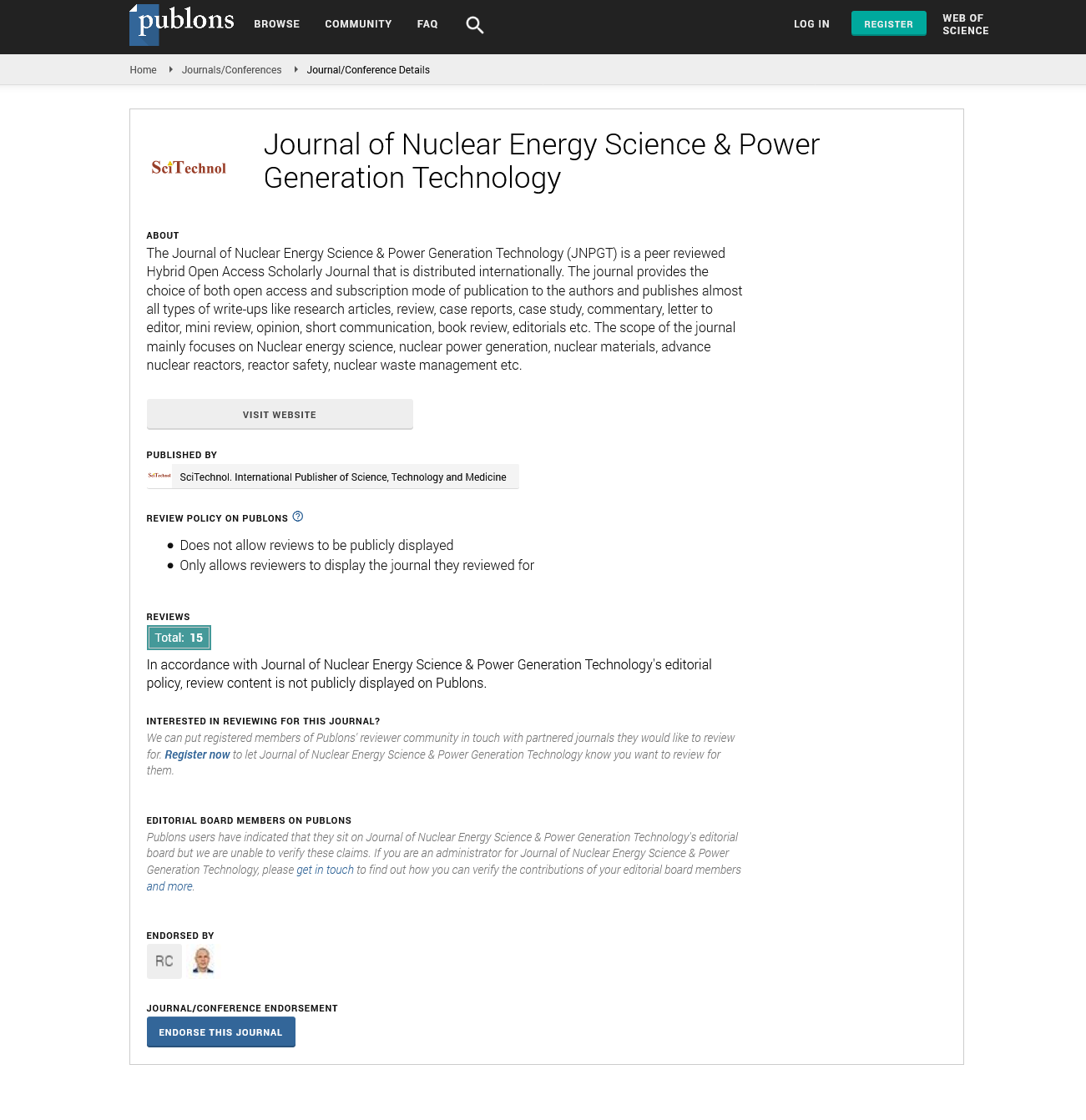Opinion Article, J Nucl Ene Sci Power Generat Technol Vol: 13 Issue: 4
Advancements in Stellarator Design: Innovations in Magnetic Coil Engineering
Stelia John*
1Department of Energy, Petroleum, Minerals Law and Policy, University of Dundee, Nethergate, UK
*Corresponding Author: Adamantia Nikolaidi, Oncology Clinic
Department of Energy, Petroleum, Minerals Law and Policy, University of Dundee,
Nethergate, UK
E-mail: stelia_john109@gmail.com
Received date: 17 June, 2024, Manuscript No. JNPGT-24-143343;
Editor assigned date: 19 June, 2024, PreQC No. JNPGT-24-143343 (PQ);
Reviewed date: 03 July, 2024, QC No. JNPGT-24-143343;
Revised date: 11 July, 2024, Manuscript No. JNPGT-24-143343 (R);
Published date: 18 July, 2024, DOI: 10.4172/2325-9809.1000408.
Citation: John S (2024) Advancements in Stellarator Design: Innovations in Magnetic Coil Engineering. J Nucl Ene Sci Power Generat Technol 13:4.
Description
The quest for sustainable and limitless energy has led scientists to explore nuclear fusion, the process that powers the stars. Among the various fusion reactor designs, the stellarator stands out for its unique approach to magnetic confinement. Unlike the more widely known tokamak, the stellarator promises continuous, steady-state operation without the need for external current drive, potentially offering a more stable and efficient path to binding fusion energy. A stellarator is a type of fusion reactor that uses complex, twisted magnetic fields to confine hot plasma. This magnetic confinement is essential because the plasma, a hot, ionized gas, must be kept at extremely high temperatures millions of degrees Celsius to facilitate the fusion reactions. At these temperatures, the plasma would melt any physical container, making magnetic confinement the only feasible method to maintain the plasma in a controlled environment.
The primary distinction between stellarators and tokamaks lies in their magnetic field configurations. Tokamaks use a combination of external magnetic coils and an induced electric current within the plasma to create a donut-shaped (toroidal) magnetic field. This design, while effective, suffers from several challenges, including instabilities and the need for pulsed operation due to the reliance on the internal current. In contrast, stellarators generate the confining magnetic field entirely with external magnets, eliminating the need for a current within the plasma and enabling continuous operation. The design of a stellarator is inherently more complex than that of a tokamak. The magnetic coils must be intricately shaped to produce the desired twisted magnetic field configuration, known as a helical or 3D magnetic field. This complexity has historically made stellarators more difficult and expensive to design and build. However, advances in computer modeling and materials science have significantly improved our ability to design and construct these intricate magnetic systems.
One of the most prominent stellarator experiments is the Wendelstein 7-X (W7-X) in Germany, operated by the Max Planck Institute for Plasma Physics. The W7-X aims to demonstrate the stellarators capability to confine plasma efficiently and sustain steadystate operation. With its advanced superconducting magnetic coils and sophisticated design, the W7-X has already achieved significant milestones, including record-breaking confinement times and high plasma temperatures. The potential advantages of stellarators over tokamaks are substantial. The absence of a plasma current reduces the risk of disruptions, which are sudden losses of confinement that can damage the reactor and halt the fusion process. This inherent stability makes stellarators attractive for long-term, reliable fusion power generation. Additionally, the continuous operation of stellarators could simplify the integration with electrical grids, providing a steady supply of fusion-generated electricity.
However, stellarators also face significant challenges. The complexity of the magnetic coil design and the precision required in construction are major hurdles. Any deviations or imperfections in the magnetic field can lead to plasma instabilities and loss of confinement. Furthermore, the development of materials that can withstand the extreme conditions within a fusion reactor, including high heat fluxes and neutron bombardment, remains a vital area of research. Despite these challenges, the progress in stellarator research is promising. The insights gained from experiments like W7-X are essential for advancing our understanding of plasma physics and improving magnetic confinement techniques. These advancements could help for next-generation stellarators that are more efficient and easier to build. In addition to technical advancements, the development of fusion energy, whether through stellarators or tokamaks, requires significant investment and international collaboration. Stellarators, with their unique benefits, are an essential part of this broader fusion research landscape.
Conclusion
In conclusion, the stellarator is a captivating and potential approach to achieving nuclear fusion. Its unique design provides potential advantages in stability and continuous operation, positioning it as a key player in the mission for sustainable fusion energy. Continued research and technological advancements are important to overcoming the challenges and realizing the full potential of stellarators in revolutionizing our energy landscape. The search of fusion energy is driven by the potential of a nearly inexhaustible energy source with minimal environmental impact. Fusion reactions produce no long-lived radioactive waste and have a negligible risk of catastrophic accidents compared to fission reactors. As the world seeks to transition to sustainable energy sources, fusion power, and specifically the development of stellarators, represents a beacon of hope for a clean and abundant energy future.
 Spanish
Spanish  Chinese
Chinese  Russian
Russian  German
German  French
French  Japanese
Japanese  Portuguese
Portuguese  Hindi
Hindi 

